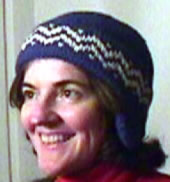
Hand Knit Ear Flap Hat
This page has a free pattern generator (aka program) to create a pattern to help you knit a hat with earflaps by hand. You can make your hat in any yarn; just enter the gauge and head size in the program, and you'll get the pattern you need. A machine knit version of this hat is available; click here.
Characteristics of the hat:
- Hand knit bottom to top in the round using circular needles
and finished with double pointed needles.
(Moderately experienced knitters can covert this to knit flat by
dividing and seaming at the back. It will require a slight amount
of figuring; email me if you are wondering what to do. I'll
admit, I can't imagine why a moderately experienced knitter would
knit the hat flat.)
- Double thickness over ears.
- Cute ear flaps -- optional!
- Pattern gives tips to make this into a head band. (Just don't knit the top of the hat.)
- Fully shaped crown. (Instructions to make the top pointy are provided as an option).
- Optional braids at bottom. ( I left them off.)
- You may vary the hat size to fit any head. (For information on head size, click here. )
- A
weekend project: I spent four hours knitting this hat using worsted
weight yarn. You can knit it in thicker yarn, and be finished
even faster.
Remember: Like all patterns spit out by my generators, this is
mostly shaping directions.
The purpose of the generators is to let you be
creative, while eliminating the need to do pesky
calculations. You might want to look at jester hats to get ideas for how to modify your hat, or color choices!